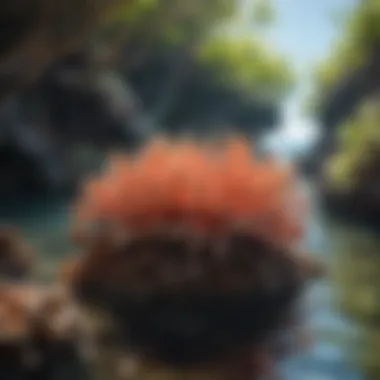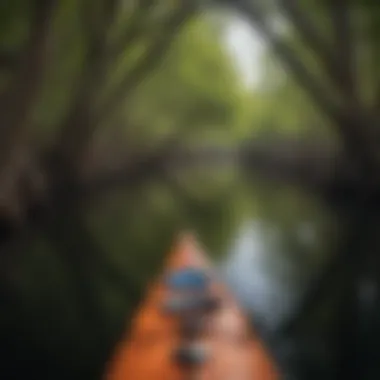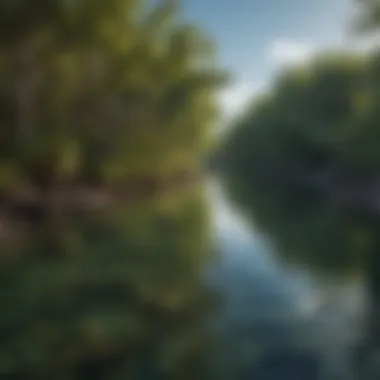Exploring John Pennekamp State Park: A Natural Treasure


Intro
John Pennekamp State Park is a notable gem situated within the Florida Keys. It is recognized for its rich biodiversity and array of recreational opportunities. The park is the first underwater park in the United States. Covering approximately 70 nautical square miles, it features coral reefs, seagrass beds, and mangroves, creating an intricate web of life.
Visitors to the park can engage in various activities, such as snorkeling, diving, kayaking, and nature walks. These attractions cater to a wide range of interests and provide direct interaction with the park's diverse ecosystems. Understanding the park's unique attributes and its ongoing conservation efforts is crucial for fostering appreciation and stewardship of this vital natural resource.
Animal Profile
General Overview
John Pennekamp State Park is home to a diverse array of wildlife. Many species thrive on its coral reefs, mangroves, and seagrass. This allows for a vibrant mix of marine and terrestrial life. Fish such as parrotfish and grouper are commonly seen. Various species of sea turtles, including the endangered loggerhead turtle, also inhabit these waters.
Habitat and Distribution
The park's marine habitats extend from the shorelines to deeper waters. Coral reefs are among the most critical components, providing essential shelter and nourishment. Meanwhile, mangrove forests serve as a crucial nursery for many fish species. These habitats are intertwined and reflect the park's ecological significance within the Florida Keys.
Fascinating Facts
Unique Traits and Adaptations
Wildlife in the park displays remarkable adaptations. For example, the parrotfish is known for its unique beak-like teeth, which it uses to scrape algae off the coral. This behavior not only helps the fish but also benefits the reef. Additionally, the sea turtles have adapted to their environment with flippers designed for powerful swimming, essential for navigating the ocean.
Historical and Cultural Significance
John Pennekamp State Park was established in 1960 and named after the prominent conservationist John D. Pennekamp. The park serves not just as a recreational space, but also as a reminder of the importance of preserving natural environments. Its creation was significant in raising awareness about marine conservation.
Conservation Status
Current Population Trends
The park's diverse wildlife populations face various challenges due to climate change, pollution, and habitat degradation. Monitoring these trends is vital to ensuring effective conservation strategies. Certain species, like the coral, have experienced declines, prompting increased conservation efforts.
Threats and Challenges
Several threats to the park’s ecosystem persist. Water quality diminishes due to runoff and urban development. Additionally, climate change leads to rising ocean temperatures, affecting coral health. Active conservation and educational initiatives are necessary to combat these challenges.
Care Tips for Pet Owners
Basic Needs and Requirements
If considering marine pets, understanding their requirements is essential. Ensure tanks replicate their natural habitat as closely as possible. This supports both their physical health and well-being.
Health and Wellness Tips
Regular tank maintenance is crucial. This includes monitoring water quality and temperature. Providing a varied diet will also contribute positively to their health. Additionally, seeking regular veterinary care helps prevent potential health issues.
“Understanding our environment and acting to protect it is an essential responsibility.”
Prelims to John Pennekamp State Park
John Pennekamp State Park holds a unique position within the Floridia Keys. Its significance extends beyond mere recreation. The park serves as a crucial sanctuary for wildlife, boasting a wealth of biodiversity. This indictment not only promotes conservation but also offers educational opportunities to visitors. Understanding the nuances of the park lays the groundwork for appreciating its invaluable contribution to both the local ecosystem and the broader efforts of environmental preservation.


Location and Overview
Located near Key Largo, John Pennekamp State Park is a coastal treasure. Spanning approximately 70 nautical miles of coral reef, it represents the first underwater park in the United States. Visitors coming from various regions can easily access the park. Its accessibility adds to its appeal. The headwaters of the park feature lush mangroves, tranquil seagrass beds, and vibrant coral reefs. This diverse environment makes it a prime destination for nature enthusiasts and adventure seekers alike.
The calm waters surrounding the park support an array of recreational activities. From snorkeling to kayaking, the location is perfect for those looking to explore. Facilities, such as picnic areas and trails, enhance the overall experience. Whether one seeks serenity or excitement, John Pennekamp maintains diverse offerings to cater to a wide audience.
Historical Significance
The park finds its historical roots in the initiative to protect marine ecosystems in the 1960s. Established in 1963, John Pennekamp State Park was named after the prominent conservationist John D. Pennekamp, who advocated for the preservation of Florida's waterways. The region's rich history is reflected in its coral formations and the diverse marine life.
Interestingly, the park plays a pivotal role in educating the public about the importance of marine conservation. Ongoing programs assist in spreading awareness about the threats faced by these ecosystems. Historical artifacts like shipwrecks also provide a glimpse into the past. Diving around these sites offers not just adventure but an encounter with history itself. These historical elements make a visit to the park not only enjoyable but also informative.
In summary, understanding John Pennekamp State Park involves looking at its location and history. Both factors contribute significantly to its standing as a Florida Keys landmark.
Ecosystems of the Park
The ecosystems of John Pennekamp State Park represent vital components of its overall ecological health and appeal. Each ecosystem contributes uniquely to the park’s biodiversity and offers numerous benefits for both wildlife and visitors. Understanding these environments is essential for appreciating their roles in sustaining life and maintaining ecological balance. The coral reefs, mangrove forests, and seagrass beds all serve as critical habitats for various species, and recognizing their importance underlines the necessity of conservation efforts.
Coral Reefs
Coral reefs in John Pennekamp State Park are among the most spectacular in North America. These reefs form complex structures that provide habitat for a myriad of marine species. They play a crucial role in protecting coastlines from erosion, supporting biodiversity, and offering recreational opportunities such as snorkeling and diving.
The coral structures not only house fish but also represent the backbone of marine ecosystems. When healthy, they maintain fish populations by serving as breeding grounds and nurseries for juvenile fish. However, these ecosystems face threats from climate change, pollution, and overfishing. Conservation measures focusing on coral restoration and pollution control are essential for their survival.
Mangrove Forests
Mangrove forests are another critical component of the park's ecosystem. These trees grow in the intertidal zone and have adapted to thrive in saline water. They offer many benefits, including stabilizing shorelines and providing essential habitats for species from fish to birds.
The roots of mangroves create a unique environment that shelters various marine life. They support juvenile fish, crustaceans, and a complex food chain that extends into larger ecosystems. Moreover, mangrove forests serve as effective carbon sinks, absorbing carbon dioxide from the atmosphere. Should they be disturbed or destroyed, the repercussions have wide-ranging effects on biodiversity and climate.
Seagrass Beds
Seagrass beds are another vital ecosystem found within John Pennekamp State Park. These underwater meadows support numerous species and help maintain water quality by filtering pollutants and trapping sediments. Seagrass beds serve as a crucial habitat for aquatic species like sea turtles, which depend on them for food.
Seagrass also plays an invaluable role in stabilizing the seabed, which prevents erosion. They provide habitats for fish and help support various crustaceans and mollusks. The decline of seagrass beds, often due to coastal development and pollution, can lead to habitat loss and the decline of species that rely on them. Maintaining these areas through education and conservation programs is vital for the health of marine ecosystems.
In summary, the ecosystems of John Pennekamp State Park are interlinked, showcasing the importance of conservation efforts. Protecting coral reefs, mangrove forests, and seagrass beds, not only benefits wildlife but also enhances recreational opportunities, ensuring future generations can enjoy and learn about these unique environments.
Wildlife and Biodiversity
The wildlife and biodiversity found within John Pennekamp State Park are fundamental to understanding its ecological value. This park serves as a sanctuary for various species, both marine and terrestrial. The blend of habitats—such as coral reefs, mangrove forests, and seagrass beds—supports a rich diversity of life, which is crucial for maintaining the ecological balance in the Florida Keys.
The health of ecosystems directly relies on the variety of species that inhabit them. Each species, whether a tiny fish or a soaring bird, plays a specific role. The loss of any single species can disrupt local ecosystems and diminish the natural beauty that attracts visitors. Furthermore, preserving biodiversity has benefits that extend beyond the park itself, influencing surrounding regions and even global ecosystems.
Marine Species
John Pennekamp State Park is renowned for its marine biodiversity. The coral reefs here are home to numerous fish species including the vibrant parrotfish and the swift barracuda. The park hosts about 600 species of fish, and among them, several are considered economically and ecologically important.
- Coral Fish: These species depend on the coral structure for shelter and feeding, maintaining a balanced food web.
- Invertebrates: From sea urchins to sponges, these animals contribute significantly to the park's marine health.
Promoting awareness about these species helps protect their habitats. The delicate balance of this marine ecosystem reflects the interdependence of organisms.
Bird Population


The diverse habitat of John Pennekamp State Park provides nesting and feeding grounds for a variety of bird species. The bird population consists of both resident and migratory birds. From holy pelicans to swift terns, these birds form an essential component of the park's biodiversity.
- Nesting Species: Many birds such as the great egret and roseate spoonbill build their nests in the mangrove areas.
- Migratory Birds: During specific seasons, migratory patterns bring thousands of birds to the park, enriching its wildlife experience.
The preservation of their habitats is critical. Protecting these species ensures that their migratory and breeding behaviors are supported.
Threatened Species
John Pennekamp State Park is also a sanctuary for several threatened and endangered species. The conservation efforts aim to protect these vulnerable populations from habitat loss and other anthropogenic pressures.
- Key Deer: A small deer species native to the Florida Keys, it is critically endangered and requires ongoing conservation efforts.
- Loggerhead Turtle: This marine turtle is often seen nesting on park beaches, making its protection vital.
Awareness of these species promotes conservation. It is a reminder that preserving such unique wildlife is not just a local priority, but a global responsibility.
"Biodiversity is the foundation for ecosystem services that our survival depends on." - Unknown
Recreational Activities
Recreational activities in John Pennekamp State Park are essential aspects of visiting and experiencing its natural beauty. The park offers a wide variety of activities that cater to different interests and skill levels. This section will delve into three popular pursuits: snorkeling and diving, kayaking and canoeing, and hiking trails. Each activity presents unique benefits that enhance visitors' connection to nature and contribute to overall well-being.
Snorkeling and Diving
Snorkeling and diving are two of the primary attractions for those who visit John Pennekamp State Park. The park’s coral reefs are home to vibrant marine life, making these activities both enjoyable and educational. Visitors can explore underwater ecosystems filled with colorful fish, corals, and various other marine organisms.
The accessibility of the reef areas allows snorkelers and divers of all skill levels to participate. It is recommended to take a guided tour to ensure safety and enrich the experience with insights from knowledgeable instructors. Benefits include:
- Enhanced appreciation of marine biodiversity: Observing marine species in their natural habitat fosters a deeper understanding of the complexities of ocean ecosystems.
- Physical health benefits: Swimming and diving improve fitness levels and promote well-being.
- Environmental awareness: Engaging with the underwater world can heighten awareness of ocean conservation issues.
Kayaking and Canoeing
Kayaking and canoeing provide an alternative view of the park’s ecosystems. Paddling through mangrove forests and seagrass beds offers tranquility and a chance to observe wildlife from a distance. These activities allow participants to traverse calm waters at their own pace, making it suitable for families and those seeking a leisurely outing.
Benefits of kayaking and canoeing include:
- Connection with nature: Being in a small boat allows visitors to immerse themselves in the surroundings, enhancing their understanding of the ecosystem.
- Physical activity: Paddling provides a full-body workout that strengthens muscles and improves cardiovascular health.
- Wildlife spotting: Many birds and marine species are more easily seen from a kayak, offering unique photo opportunities.
Hiking Trails
Hiking trails within John Pennekamp State Park allow visitors to explore the diverse landscapes on land. Well-marked paths offer different levels of difficulty, accommodating beginners and experienced hikers alike. Trails meander through tropical hardwood forests, providing a glimpse into the park's terrestrial ecosystems.
Hiking not only promotes physical fitness but also encourages mental clarity and stress relief. Key aspects of hiking in the park include:
- Natural exploration: Trails expose visitors to various plant species and wildlife, fostering an understanding of the area's ecology.
- Scenic views: Many trails open to picturesque vistas, rewarding hikers with remarkable sights.
- Social interaction: Trails can be a social setting, where visitors meet others interested in nature and outdoor activities.
Engaging in these recreational activities not only enhances appreciation for John Pennekamp State Park but also promotes overall health and well-being. It is crucial that participants observe park guidelines to protect both the environment and themselves while enjoying these outdoor experiences.
Conservation Efforts
Conservation efforts are crucial for the protection and preservation of John Pennekamp State Park. This region is not only a scenic destination but also a vital habitat for diverse species. Efforts in this area ensure that the ecosystems remain balanced and that wildlife continues to thrive. The park serves as an example of effective conservation practices.
Restoration Projects


Restoration projects within John Pennekamp State Park focus on rehabilitating damaged ecosystems. Coral reefs, for instance, have seen significant restoration efforts. These projects often involve artificial reef construction to provide new habitats for marine life. Also, seagrass beds receive attention due to their role in supporting fish species and improving water quality. Restoration helps maintain biodiversity and strengthens the resilience of the ecosystems against future disturbances.
Educational Programs
Educational programs in the park aim to raise awareness about environmental conservation. These initiatives engage visitors, educators, and students alike. Through guided tours and workshops, participants learn about the unique ecosystems found in the park. Topics often cover coral reef ecology, the importance of mangroves, and the role of seagrass. By empowering the public with knowledge, these programs promote a culture of conservation.
Community Involvement
Community involvement is a key aspect of conservation efforts in the park. Local organizations often collaborate with park management to organize clean-up events and conservation volunteering days. This engagement fosters a sense of ownership among residents and tourists alike. When people see their contributions helping the ecosystem, they are more likely to advocate for sustainable practices. Thus, community involvement is not merely beneficial but essential for long-term conservation success.
“The key to sustaining our natural treasures lies in the commitment of both the volunteers and the state to protect them.”
Visitor Information
Visitor information is crucial for anyone planning a trip to John Pennekamp State Park. This section provides essential details that enhance the visitor experience and ensure a safe and enjoyable time in the park. Knowing the park hours, fees, available amenities, and safety guidelines is vital for all guests. This knowledge not only aids in trip planning but also supports visitor awareness of the park's features and regulations.
Park Hours and Fees
Understanding the operational hours of John Pennekamp State Park helps visitors maximize their time. The park typically opens at 8:00 AM and closes at sunset. Fees may vary, depending on whether visitors are entering as a pedestrian, cyclist, or vehicle owner. As of now, the entrance fee is around $8 for a vehicle containing up to eight people, while pedestrians and cyclists may pay a lesser fee of around $4 each. Prices can change, so it is wise for visitors to check the official website or contact park staff for the most up-to-date information. This fee helps fund park maintenance and conservation efforts.
Amenities Available
John Pennekamp State Park offers a variety of amenities that enhance the visitor experience. Some of the key amenities include:
- Restrooms: Well-maintained bathroom facilities are available near key locations within the park.
- Picnic Areas: Multiple picnic spots are provided for guests who wish to enjoy meals in nature.
- Visitor Center: This center features educational displays about the park’s ecosystems and offers local maps and guides.
- Equipment Rentals: Snorkeling gear, kayaks, and canoes are available for rent, making it easier for visitors to access recreational activities.
The availability of these amenities contributes significantly to visitor satisfaction, ensuring that practical needs are met while enjoying the natural beauty of the park.
Safety Guidelines
Visitors to John Pennekamp State Park should adhere to safety guidelines to ensure a safe experience. It is essential to be aware of the following practices:
- Sun Protection: Due to strong sunlight, wearing sunscreen, hats, and sunglasses is advised.
- Hydration: Keeping hydrated, especially during outdoor activities, is crucial.
- Wildlife: Do not feed or approach wildlife; keep a safe distance to prevent harm to both animals and humans.
- Snorkeling Safety: For those engaging in water activities, wearing a life jacket is recommended. It is also wise to stay within designated areas as strong currents can pose dangers.
A combination of awareness and preparedness can enhance the overall experience in John Pennekamp State Park, promoting both safety and enjoyment.
Epilogue
The conclusion of this article serves as a critical summary, synthesizing insights about John Pennekamp State Park. Understanding this park is not just about appreciating its natural beauty; it also involves recognizing its ecological importance and the role it plays in conservation. The diverse ecosystems within the park, such as coral reefs, mangrove forests, and seagrass beds, are vital not only for marine wildlife but also for the health of the larger environment.
In addition to its ecological significance, the recreational opportunities offered by the park attract many visitors. Activities like snorkeling, kayaking, and hiking provide ways for people to connect with nature. Engaging in these activities fosters a deeper connection to environmental issues and awareness of conservation needs.
The conclusion also highlights the urgency of ongoing conservation efforts. Projects aimed at restoring damaged habitats, along with educational initiatives targeting visitors for awareness, ensure that the park remains a preserved haven for future generations. By examining the park's multifaceted offerings and challenges, readers can better appreciate what makes John Pennekamp State Park a valuable resource.
Final Thoughts
Final thoughts emphasize the responsibility each visitor carries when they step into John Pennekamp State Park. Engaging with nature offers both enjoyment and an opportunity to reflect on its fragility. Visitors are reminded that their actions can have significant impacts on the ecosystems that thrive within the park. Appreciating the beauty found here comes with the understanding that human activity can both harm and help these environments.
Moreover, educated visitors can contribute to the narrative of conservation. Awareness leads to action. As individuals explore the park, they are encouraged to observe and report environmental issues. Whether it's litter on the beach or signs of distress in marine life, these small actions can collectively foster a culture of care and stewardship within the community.
Encouraging Conservation Awareness
Encouraging conservation awareness is central to promoting the value of John Pennekamp State Park. The partnership between the park’s management and visitors is paramount. When visitors understand the critical roles these ecosystems play, they can become advocates for change.
Here are some recommended ways to increase awareness and engagement:
- Participate in local clean-up efforts.
- Attend educational programs offered in the park.
- Share experiences via social media to inspire others.
- Support conservation organizations.
Fostering a culture of conservation begins with knowledge. By creating educational materials and interactive experiences, the park can draw attention to the urgent need for protection against climate change, pollution, and habitat destruction. Sustained awareness can lead to a long-lasting impact on the park’s health, ultimately benefiting not just the ecosystems but the visitors who cherish this natural treasure. By valuing conservation, we ensure that future generations have the same opportunity to experience the distinguishing characteristics that make John Pennekamp State Park a vital part of Florida's ecological network.















